November 9, 2017
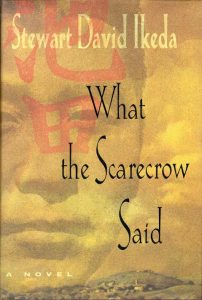
Stewart David Ikeda, What the Scarecrow Said (1996)
Novel centering on William Fujita, a successful Nisei nursery owner before the war as he tries to rebuild his life in New England after camp having lost both his son and wife in the war. Dispatched to start a small farming operation for a widowed nurse in the small Quaker town of Juggeston in late 1944, Fujita navigates the tricky politics of the area, while tying up loose ends of his former life. The early chapters alternate between Fujita’s prewar life and his new life on “Widow’s Peak.” A sometimes eccentric, funny, and moving story of “resettlement,” Scarecrow is about resilience in middle age in the face of tragedy.
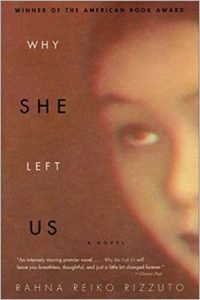
Rahna Reiko Rizzuto, Why She Left Us (1999)
Like many of these novels, Why She Left Us jumps back and forth in time with characters in the redress era trying to untangle family mysteries that originate from the war years. At the center of the story is the enigmatic Emi Okada who finds herself incarcerated at Santa Anita and Amache with two young children and no husband. The story is told in the first person voices of four different characters—none of whom are Emi—who each know only part of the story. I like that the novel defies all stereotypes and that it leaves many of the questions of the past unanswered, much as real life often does.

Julie Otsuka, When the Emperor Was Divine (2002)
Probably the most acclaimed and best-selling book of this group, Emperor is a deceptively simple story based on Otsuka’s mother’s family incarceration experience. A seemingly successful family of four living in Berkeley prior to the war, the unnamed family sees the father taken away to an internment camp the day after the attack on Pearl Harbor, and the mother and two young children later removed to Tanforan and Topaz. Each of the five chapters is told from the perspective of a different character. Because much of it is told from the perspective of one or both children, it has been adopted by many high schools and colleges and is a fine introduction to the story. But perhaps because I’ve read so many similar accounts, I found myself a little bored and drawn to some of the other more unusual storylines.

Perry Miyake, 21st Century Manzanar (2002)
… like this one, a (very) black comedy about an early 21st century roundup of Japanese Americans and how Sansei and Yonsei would react to it. Though written in the 1990s and inspired by the “trade war” with Japan (the ostensible reason for the “ReVac”) and American attitudes towards Arab Americans during the Gulf War, it reads as if were written last week. Sansei claims that they would have resisted forced removal in the 1940s are put to the test when they face the same fate sixty years later. Miyake mixes in many references to the WWII incarceration—everything from camp administrators more concerned with good PR than with the fate of the inmates, Nikkei collaborators, and youth unrest—while also mixing in affectionate descriptions of the 1970s Japanese American community in LA and of the Asian American Movement. Though initially bleak, the story ends up being oddly uplifting in the end.
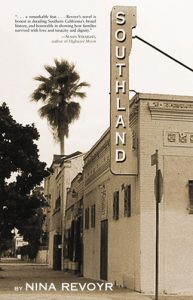
Nina Revoyr, Southland (2003)
Another book that sees a Sansei/Yonsei character in the present (in this case 1994) drawn into unraveling a mystery of the past, the twist here is that the mystery has its roots in the 1965 Watts uprising. The story begins when Yonsei law student Jackie Ishida is asked by an aunt to look into an odd element of her late Nisei grandfather’s will: a clause that leaves the grocery store he had once owned in the Crenshaw neighborhood of Los Angeles—and a sizable sum of cash—to a Curtis Martindale, a name none of the family members had heard of. Jackie’s journey uncovers a rich story of Nisei life in Los Angeles—and in Manzanar and the 442nd Regimental Combat Team—and brings her a deeper sense of her own legacy. Probably my favorite book on this list, Southland is tremendously moving and one of the best books ever written about Los Angeles.

Jeanne Wakatsuki Houston, The Legend of Fire Horse Woman (2003)
Thirty years after Farewell to Manzanar, Jeanne Wakatsuki Houston’s debut novel is largely an Issei story, moving back and forth in time between the war years in Manzanar (though the camp is never explicitly named, everything about it conforms to Manzanar) and the early life of protagonist Sayo Matsubara, a feisty picture bride. Inspired by her parents’ early life, interviews she conducted with picture brides, and by ties between Japanese Americans and Native Americans, Houston tells a decidedly woman-centered story of incarceration and rebellion.

John Hamamura, Color of the Sea (2006)
Nikkei wartime narrative in the form of a coming-of-age novel with Kibei Sam Hamada at its center. Taking place in Hawai’i, California, and Japan, the story incorporates Sam’s prewar story, his service in the Military Intelligence Service, and the atomic bombs and their aftermath. He falls for a Nisei woman in California named Keiko Yanagi, and her family story brings in the Japanese American incarceration at Stockton and Jerome. Though a dramatic story that is generally well told, I can’t help but compare it to Pamela Rottner Sakamoto’s novel-like Midnight at Broad Daylight, a similar story about a real Kibei war hero that I would recommend instead.
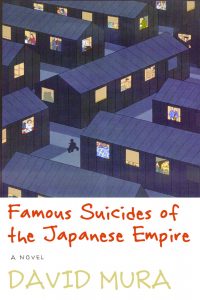
David Mura, Famous Suicides of the Japanese Empire (2008)
First novel by acclaimed poet and memoirist David Mura that explores the impact of wartime incarceration—and the silences about it—on a Japanese American family in Chicago after World War II, through the eyes of a forty-something Sansei. Ben Ohara, a community college history professor—whose long delayed book in progress provides the novel’s title—is driven to explore his and his family’s difficult past, much of which is influenced by his father’s “no-no boy”/draft resister status. (Mura keeps the father’s actual status purposely vague, mirroring Ben’s—and the community at large’s—confusion between the two.) A vivid portrayal of the continuing impact of the wartime incarceration on the next generation, Famous Suicides peers beneath the surface of the “model minority” image.
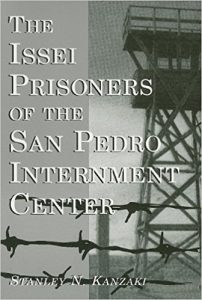
Stanley N. Kanzaki, The Issei Prisoners of the San Pedro Internment Center (2009)
Featuring another misleading title, this is indeed a novel told from the perspective of Issei internees. The first half of the book is about the almost charmed life of Kenji Yamato, a highly educated and bilingual Issei man who straddles the Issei and Nisei worlds and who makes unexpected headway in the white world. The second half of the books shifts tones abruptly to cover life and death in an enemy alien internment camp in the New Mexico desert during World War II. One of the more convincing portrayals of Issei life, Prisoners illuminates the often ignored impact of internment/incarceration on the pioneering generation.
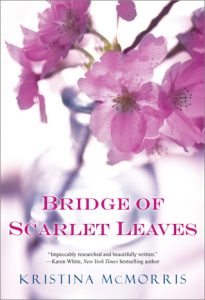
Kristina McMorris, Bridge of Scarlet Leaves (2012)
Though in some ways a formulaic romance between an inevitably beautiful white protagonist and a handsome Nisei Stanford student, this is nonetheless an enjoyable read that sees the headstrong heroine opt to join her beau at Manzanar. Though like Southland‘s Revoyr, McMorris is the daughter of a postwar Japanese immigrant (her father is the “Mr. Yoshida” of sauce fame) and thus has no familial tie to the incarceration, the Nikkei characters are convincingly drawn. She also provides a lengthy “Author’s Note” on the background of the book and the historical liberties taken and even includes five pages of “Asian-Fusion Recipes”!

Jan Morrill, The Red Kimono (2013)
Novel that tells parallel stories of a Japanese American family that is uprooted from their Berkeley, California, home and sent to American concentration camps during World War II, and a young African American man who goes to prison for the beating death of that family’s patriarch. While intriguing for its exploration of interethnic connections and of Japanese American prejudices, the plot has many implausibilities, and the Issei characters don’t ring true.

Gene Oishi, Fox Drum Bebop (2014)
Autobiographical novel by the former Baltimore Sun journalist tells the story of the Kono family covering the years 1940 to 1982. While the early chapters covering their prosperous prewar life and World War II incarceration are told from the perspective of various family members, the postwar chapters are told from the perspective of Hiroshi, Oishi’s alter ego, tracing his love of jazz, his stint in the army, love and marriage, his journalism career, and the lingering impacts of the wartime incarceration in colorful fashion. If one reads the Nisei press of the 1930s through 1950s, one will find many mentions of the “Great Nisei Novel.” (See, for instance, Larry Tajiri’s “Nisei USA” column in the September 21, 1946 edition of the Pacific Citizen, page 4.) In its panoramic scope; frank, funny, and lively voice; and reflection on the meaning of being Nisei, could this, likely the last Nisei novel, be the closest we will ever get?
I somewhat arbitrarily cut off the list at 1996, but there are some worthwhile older works as well, such as Yoshiko Uchida’s Picture Bride (1987) and Julie Shigekuni’s A Bridge Between Us (1995). I’ll write separately about books for children/young adults and of recent memoirs by Japanese Americans. I didn’t include some recent novels that center on the lingering impact of the incarceration but that don’t actually tell us much about the incarceration itself, such as Julie Shigekuni’s Unending Nora or Nick Nagatani’s Buddhahead Trilogy, nor the enjoyable series of Mas Arai mystery novels by Naomi Hirahara, which, though set in the 1990s and 2000s, all seem to turn on some key event that happened during the war years. So stay tuned!
—
By Densho Content Director Brian Niiya
[Header photo: Original caption: San Bruno, California. A barrack building at this assembly center has been reserved for the library which has just been established with a trained librarian of Japanese ancestry in charge. All books and magazines have been donated and the shelves were made from scrap lumber by the evacuees. June 16, 1942. Courtesy of the National Archives and Records Administration.]

